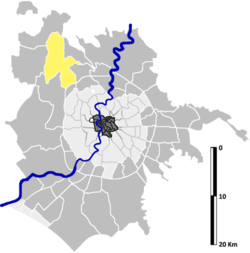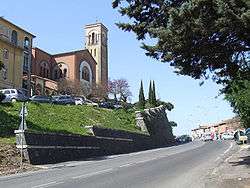La Storta
| La Storta | |
|---|---|
| Zona | |
|
The Cathedral of the Sacred Hearts of Jesus and Mary, along the Via Cassia in La Storta | |
 Location of La Storta in relation to the outer zones of Rome | |
 La Storta Location of La Storta in Italy | |
| Coordinates: 42°32′8″N 12°22′42″E / 42.53556°N 12.37833°ECoordinates: 42°32′8″N 12°22′42″E / 42.53556°N 12.37833°E | |
| Country |
|
| Region |
|
| Province | Rome (RM) |
| City | Rome |
| Area[1] | |
| • Total | 46.67 km2 (18.02 sq mi) |
| Population | |
| • Total | 18,594 |
La Storta is a frazione and a zona in the Ager Romanus, the rural area surrounding Rome. It is designated by the code Z. LI as the 51st of 59 zone that are part of the administrative subdivision of Rome. Located to the north west of the city, it falls within the boundaries of Municipio XV.[note 1] The population is 18,594.[1]
Name
The name La Storta ("the curve"; literally twisted or bent) refers to a series of curves that the Via Cassia makes through the settlement.[2]
History
Statio on the Via Francigena
During the Middle Ages the locality was positioned along the Via Francigena, and was specifically mentioned as being a stop on the itinerary of Sigeric the Serious during his journey to Rome to accept the pallium as archbishop of Canterbury.[3] The surviving account of his journey refers to La Storta as [Submansio] Joannis VIIII, the first stop outside of the city of Rome.[note 2] The stop was also referred to as San Giovanni in Nono (Latin: Sanctus Ioannes in Nono), since the way station was constructed next to a church dedicated to Saint John, and positioned at the nine-mile marker from the start of the Via Cassia.[4]
Vision of Saint Ignatius
In November 1537, Ignatius of Loyola was traveling the Via Cassia towards Rome, accompanied by Peter Faber and Diego Laynez. The group paused at a small church in La Storta to pray.[5] It was there that Ignatius is reported to have received a vision of God the Father and Christ holding the cross. Ignatius would later report that the Father had "given him ... to be henceforward consecrated wholly to His service," and Christ spoke the words Ego tibi Romae propitius ero ("I will be favorable to you in Rome").[5][6] The meaning of the sentence was not immediately clear to Ignatius, who thought it could mean that the three might be martyred at Rome.[5] Pope Paul III instead gave him a very friendly reception.[5]
The location of the apparition is memorialized today with a small chapel dedicated to Saint Ignatius in the Piazza della Visione ("Square of the Vision").[7] The site of the vision was a place of pilgrimage from the early days of the Society of Jesus, but the current form of the chapel was achieved only in the year 1700, when it was restored and decorated by the Superior General Thyrsus González de Santalla.[7] The community celebrates the vision with its own feast day, the Feast of the Vision of Saint Ignatius.[8] (The feast day is not, however, an ancient tradition, having been celebrated for the first time in 2011.) The feast is celebrated on the second Sunday of November, and is marked by processions, bands, and a reenactment of the vision.[8]
La Storta Massacre
On June 4, 1944, the Nazis, who were fleeing from Rome after its liberation, carried out the massacre of fourteen prisoners in the community. Twelve of the fourteen were Italians, including the trade unionist Bruno Buozzi; the other two were a Polish Jew and the Englishman John Armstrong.[1] The German soldiers were moving out in a column of vehicles during the night of June 3 to June 4, attempting to escape the Allied advance on the city, and executed the prisoners on the grounds of the Grazioli estate in the country, a forested area 14 km (8.7 mi) down the Via Cassia from La Storta.[1] It is not known who issued the order.[1]
Ecclesiastical territory
La Storta is the seat of the bishop of the Suburbicarian Diocese of Porto-Santa Rufina,[9] the territory of which stretches from the GRA to the Tyrrhenian Sea.[10]
The Cathedral of the Sacred Hearts of Jesus and Mary (Italian: Cattedrale dei Sacri Cuori di Gesù e Maria) is located in La Storta. The construction of the present-day cathedral building was abandoned in 1926, having been a project of a German Jesuit, Father Leopoldo Fonck, who intended the church to be dedicated to Saint Margaret Mary Alacoque.[11] Construction was suspended, however, and the building was not completed until Cardinal Tisserant took a personal interest and raised funds from sources including the United States.[11] The new cathedral was dedicated on March 25, 1950, hosted a diocesan synod in August 1957, and was visited by Pope Pius XII on October 27 of the same year.[11] In 1990, construction of a diocesan curia building was completed nearby.[11]
Education
The settlement is home to St. George's British International School, founded in 1958.[12]
Notes and references
| Wikimedia Commons has media related to La Storta. |
- Notes
- ↑ It was previously part of both Municipi XIX and XX.[1] See the Italian Wikipedia page for Municipio XV, which lists La Storta as Subdisivion 20h.
- ↑ Submansio means "lodging" or "stage," in reference to one day's journey. The so-called Itinerary of Sigeric is preserved among the Reliquiae Dunstanianae, the Memorials of Saint Dunstan (Cotton MS Tiberius B V, f. 23 v°), and date from 990 AD.[3]
- References
- 1 2 3 4 5 6 "Informazioni Generali sui Territori". Roma Capitale. Retrieved March 6, 2014.
- ↑ McManamon, John (2013). The Text and Contexts of Ignatius Loyola's "Autobiography". Fordham University Press. p. 84. ISBN 0823245047.
- 1 2 William Stubbs, ed. (1874). "XXIV. Adventus Archiepiscopi Nostri Sigerici ad Romam". Memorials of Saint Dunstan. London: Longman & Co. pp. 391–392.
- ↑ "Il Parco di Veio e i suoi paesi". Consorzio BAICR Sistema Cultura. Retrieved 24 March 2014.
|first1=missing|last1=in Authors list (help) - 1 2 3 4 Rose, Stewart (1870). Ignatius Loyola and the Early Jesuits. London: Longmans, Green, and Co. pp. 192–195.
- ↑ "Ignatian Rome: La Storta". Jesuit Curia in Rome. 2014. Retrieved March 6, 2014.
- 1 2 "Cappella della Visione". Parrocchia Sacri Cuori di Gesù e Maria. Retrieved March 6, 2014.
- 1 2 Furgoni, Adriano (March 11, 2011). "Io a Roma sarò con voi!". Diocesi di Porto - Santa Rufina. Retrieved March 6, 2014.
- ↑ "Curia Vescovile della Diocesi Suburbicaria di Porto - Santa Rufina". Roman Catholic Suburbicarian Diocese of Porto-Santa Rufina. Retrieved 23 March 2014.
- ↑ "La Diocesi Suburbicaria di Porto - Santa Rufina [Italian]". Santa Rufina. Retrieved 23 March 2014.
- 1 2 3 4 "Cenni di storia della Diocesi". Diocesi di Porto - Santa Rufina. Retrieved March 6, 2014.
- ↑ "Locations". St. George's International School. 2012. Retrieved March 23, 2014.
